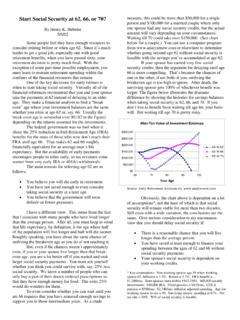Transcription of Modelling Social Messes with Morphological Analysis
1 Acta Morphologica Generalis AMG (2013) Swedish Morphological Society ISSN 2001-2241 Wicked Problems Modelling Social Messes with Morphological Analysis Tom Ritchey Swedish Morphological Society ( 2005, revised 2013) If you work in an organisation that deals with Social , commercial or financial planning or any type of public policy planning then you ve got wicked problems. You may not call them by this name, but you know what they are. They are those complex, ever changing societal and organisational planning problems that you haven t been able to treat with much success, because they won t keep still. They re messy, devious, and they fight back when you try to deal with them. This paper de-scribes the notion of wicked problems (WPs) as put forward by Rittel & Webber in their landmark article Dilemmas in a General Theory of Planning (1973).
2 It presents the ten criteria they use to characterise WPS, and describes how General Morphological Analysis (GMA) can be used to model and analyse such problem complexes. Keywords: Wicked problems, general Morphological Analysis , policy Analysis , Horst Rittel Introduction: What are wicked problems ? In 1973, Horst Rittel and Melvin Webber, both urban planners at the University of Berkley in Cali-fornia, wrote an article for Policy Sciences with an astounding title: Dilemmas in a General Theory of Planning . In this article, the authors observed that there is a whole realm of Social and organisa-tional planning problems that cannot be successfully treated with traditional linear, analytical (sys-tems-engineering-like) approaches. They called these wicked problems, in contrast to tame problems. At first glance, it is not self-evident what is actually meant by this term.
3 Both the words wicked and problem need to be qualified: Problems are wicked not in the sense of being evil , but in that they are seriously devious and can have (nasty) unintended consequences for the planners who try to do something about them. Furthermore, as a decision maker, whatever decision you make, a good portion of the stakeholders involved (often a majority of them!) are going to want your head on a block! Also, wicked problems are not actually problems in the sense of having well defined and stable problem statements. They are too chaotic for this, which is why they have also been called Social Messes (Horn, 2001) and unstructured reality (Ackoff, 1974) One need only read Rittel & Webber s wonderfully provocative abstract in order to understand how politically un-correct their article was at the time: This is a revised and extended version of an earlier article (2005) based on a lecture given at the Royal Institute of Tech-nology (KTH) in Stockholm, 2004.
4 Contact: T. Ritchey / Acta Morphologica Generalis Vol. 2. No. 1 (2013) _____ 2 The search for scientific bases for confronting problems of Social policy is bound to fail, because of the nature of these problems. They are wicked problems, whereas science has de-veloped to deal with tame problems. Policy problems cannot be definitively described. Moreover, in a pluralistic society there is nothing like the undisputable public good; there is no objective definition of equity; policies that respond to Social problems cannot be meaningfully correct or false; and it makes no sense to talk about optimal solutions to Social problems unless severe qualifications are imposed first. Even worse, there are no solutions in the sense of definitive and objective answers. (Rittel & Webber, 1973, Abstract.) Some say that we are wiser today, and less susceptible to the belief that complex Social planning problems can be solved by linear methods akin to engineering solutions.
5 I am not so sure about this. In any event, it is instructive to look at the original formulation of the distinction between wicked and tame problems. First, let s look at some of the things that characterise a tame problem. A tame problem has a relatively well-defined and stable problem statement. has a definite stopping point, we know when a solution is reached. has a solution which can be objectively evaluated as being right or wrong. belongs to a class of similar problems which can be solved in a similar manner. has solutions which can be tried and abandoned. Wicked problems are completely different. Wicked problems are ill-defined, ambiguous and associ-ated with strong moral, political and professional issues. Since they are strongly stakeholder depend-ent, there is often little consensus about what the problem is, let alone how to deal with it.
6 Above all, wicked problems won t keep still: they are sets of complex, interacting issues evolving in a dynamic Social context. Often, new forms of wicked problems emerge as a result of trying to understand and treat one of them. The classical systems approach .. is based on the assumption that a planning project can be organized into distinct phases: understand the problems , gather information, synthesize information and wait for the creative leap, work out solutions and the like. For wicked problems, however, this type of scheme does not work. One cannot understand the problem without knowing about its context; one cannot meaningfully search for information without the orientation of a solution concept; one cannot first understand, then solve. (Rittel & Web-ber, 1973, p. 161.) The most evident, and important, wicked problems are complex, long-term Social and organisational planning problems.
7 Examples: How should we fight the War on Terrorism? How should scientific and technological development be governed? What is a good national immigration policy? How do we get genuine democracies to emerge from authoritarian regimes? How should we deal with crime and violence in our schools? How should our organisation develop in the face of an increasingly uncertain future? In his work on Wicked Problems and Social Complexity (2001), Jeff Conklin writes: .. there are two common organizational coping mechanisms that are routinely applied to wicked problems: studying the problem, and taming it. While studying a novel and complex problem is natural and important, it is an approach that will run out of gas quickly if the problem is wicked. Pure study amounts to procrastination, because lit-tle can be learned about a wicked problem by objective data gathering and Analysis .
8 Wicked prob-lems demand an opportunity-driven approach; they require making decisions, doing experiments, T. Ritchey / Acta Morphologica Generalis Vol. 2. No. 1 (2013) _____ 3 launching pilot programs, testing prototypes, and so on. Study alone leads to more study, and re-sults in the condition known as Analysis paralysis, a Catch 22 in which we can t take action until we have more information, but we can t get more information until someone takes action.. attempting to tame a wicked problem, while appealing in the short run, fails in the long run. The wicked problem simply reasserts itself, perhaps in a different guise, as if nothing had been done. Or, worse, sometimes the tame solution exacerbates the problem. (p. 10f.) Of course, problems are wicked and tame only a potiori. In practice there is a sort of gliding scale between tameness and wickedness.
9 There is, however, a set of pretty clear criteria for judging the degree of wickedness (so to speak) associated with complex Social and organisational planning problems. We will look at Rittel and Webber s ten criteria shortly. Also, the problem that the concept of wicked problems addresses did not suddenly emerge in the late 1960 s and early 1970 s. WPs are about people, vested interests and politics. As such, they are as old as human society itself. So, why did a number of different policy researchers start fussing about this issue all at the same time in the late 1960 s? During a presentation of General Morphological Analysis (GMA) in the 1990 s, I naively put this question to a group of security specialists (see Ritchey, 2011). They practically fell off their chairs with laughter! What was going on? The Vietnam War was going on, along with the War on Poverty and the War on Drugs.
10 All of these wars were essentially managed (badly) like huge engineering projects, and all ultimately bogged down or went seriously wrong. Also going on , as a reaction to government policy (or lack thereof), were the Civil Rights Movement, the anti-war demonstrations and the general baby boomer revolution . It is no wonder that academics representing Social planners and policy professionals sought a new awareness and new modes of explanation. As Rittel & Webber put it in 1973 (I paraphrase): The publics are not going to take it any longer, and planners are going to be held accountable for what they do, or don t do. (Wouldn t that have been nice?) So what is the problem that the term wicked problem addresses? The common sense approach to WPs is fairly straight forward: As stated above, WPs are about people the most complex adaptive systems that we know of.









